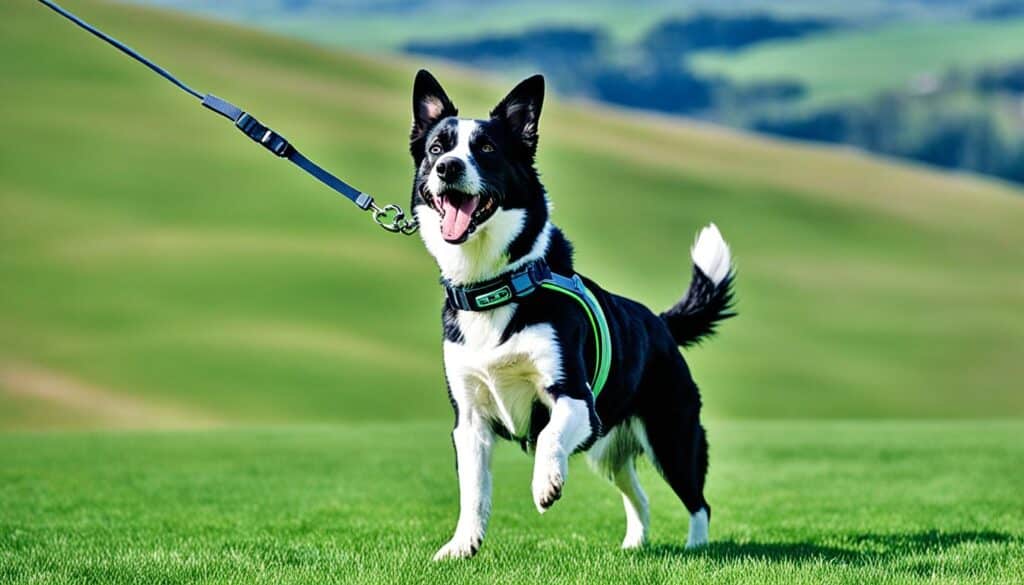
Using a long leash can be a game-changer when it comes to dog training. An essential tool for dog owners, a long leash offers numerous benefits and allows for effective training strategies. Whether you want to improve behavior control, enhance recall training, or provide your furry friend more freedom, a long leash can help you achieve your goals.
In this article, we will explore the world of dog training with a long leash and delve into the strategies to make this training method successful. From understanding why you should use a long leash to choosing the right one and mastering the proper techniques, we will cover everything you need to know to become a master in long leash training.
Key Takeaways:
- Using a long leash can significantly impact behavior control and recall training.
- Choosing the right long leash is crucial for optimal training results.
- Proper leash handling and techniques are essential for practical long-leash training.
- Long leash training provides dogs with more freedom while maintaining control.
- Be prepared to troubleshoot common problems that may arise during long leash training.
Why use a long leash for dog training?
When it comes to dog training, using a long leash can be an invaluable tool. It offers numerous benefits that contribute to the overall success of your training sessions. Whether teaching your dog basic commands, working on recall, or improving behavior control, a long leash can provide the freedom and control needed to achieve optimal results.
Benefits of using a long leash in dog training
Using a long leash in dog training offers several advantages that enhance your training experience. One of the most significant benefits is the increased freedom it gives your dog. With a long leash, your canine companion can explore the environment, essential for mental and physical stimulation.
Additionally, a long leash plays a crucial role in recall training. It allows you to gradually increase the distance between yourself and your dog while maintaining control. This training technique builds trust and improves your dog’s response to recall commands.
Moreover, a long leash enhances behavior control during training sessions. It enables you to guide your dog’s movements and prevent potential misbehaviors while teaching them appropriate behaviors, such as loose leash walking and polite greetings.
Using the right long leash for optimal results
To achieve optimal results in dog training, selecting the right long leash is essential. Consider the length of the leash, considering the specific training needs and environment. A longer leash is ideal for recall training in open spaces, while a shorter one may be suitable for leash training in more confined areas.
Furthermore, pay attention to the material and quality of the long leash. Opt for durable materials like nylon or biothane that withstand regular use and tangling. A well-made long leash ensures your comfort and your dog’s safety during training sessions.
How do you properly use a long leash for your dog?
Regarding dog training, using a long leash can be a valuable tool for safety and control. However, it’s essential to understand how to properly use a long leash to ensure the top results for your furry friend.
Choosing the suitable leash material for safety and comfort
To begin with, selecting a suitable leash material is crucial for ensuring the safety and comfort of your dog during training sessions. Two popular options for long-leash materials are biothane and leather.
Biothane leashes are durable and water-resistant, making them suitable for various weather conditions. They are also ease to clean, which is especially useful during outdoor training activities.
On the other hand, leather leashes provide a classic and aesthetic appeal. They are known for their strength and flexibility, allowing for a comfortable grip in your hand. However, leather leashes require regular maintenance to keep them in good condition.
Whichever material you choose, ensure the leash is high quality and appropriately sized for your dog’s weight and strength. This will ensure both their comfort and your control during training sessions.
Protecting your dog during training with a long leash
Aside from selecting the suitable leash material, protecting your dog during training is of utmost importance. One key aspect is using an appropriate harness or collar with a long leash.
A harness is recommended for dogs that tend to pull or have respiratory issues. It distributes the force evenly across the chest and back, reducing strain on your dog’s neck and throat. A well-fitted harness will enhance their comfort and overall safety during training sessions.
When attaching the leash to the harness or collar, ensure a secure connection that prevents potential escape or accidental detachment. It’s essential to regularly check the leash attachment to ensure it remains intact throughout the training session.
Additionally, be mindful of any discomfort or harm the leash may cause your dog. Avoid using excessive force or applying sudden jerks that may cause injury. Always prioritize their safety and well-being above all else.

Effective long-leash training techniques for your dog
To train your dog effectively using a long leash, it is essential to understand how to utilize this tool correctly. This section will provide detailed instructions on using the long leash in recall training and specific exercises for leash training and behavior improvement. Additionally, it will highlight the importance of maintaining control while using a long leash during training sessions.
Use of the long leash in recall training
Recall training is crucial for ensuring that your dog responds promptly when called. The long leash can be a valuable tool in reinforcing the recall command and allowing your dog to practice this behavior.
Begin recall training in a controlled environment like a fenced yard or quiet park. Attach the long leash to your dog’s collar or harness, allowing them some slack. Start by giving the recall command, using a clear and consistent voice. When your dog begins to move towards you, gently guide them using the long leash, applying slight tension if necessary.
As your dog becomes more proficient in recall training, the distance and distractions gradually increase. Practice in different environments, introducing progressively more challenging distractions, such as other dogs or tempting smells. Remember always to reward your dog when they successfully respond to the recall command, reinforcing the positive behavior.
Long leash exercises for leash training and behavior
The long leash can improve leash training and address specific behavior issues. Incorporating exercises that focus on leash manners and obedience can help establish better control and communication between you and your dog.
One effective exercise is the “follow me” exercise. Begin by attaching the long leash to your dog’s collar or harness. Start walking forward, encouraging your dog to follow you. If your dog begins to pull or stray off course, gently apply pressure on the leash to redirect their attention back to you. Reward your dog with praise and treats when they walk calmly by your side.
Another exercise involves using a long leash to practice impulse control. Find a location with distractions, such as a park or busy sidewalk. Allow your dog some freedom with the long leash, but maintain control by gently guiding them away from distractions using the leash. Gradually increase the level of difficulty by introducing more tempting distractions and reinforcing self-control.
Keeping your dog under control with a long leash
While using a long leash during training, it is essential to maintain control of your dog to ensure their safety and the effectiveness of the training. Always hold the long leash securely and be prepared to react if your dog pulls or exhibits unwanted behavior.
Practice proper leash handling techniques, keeping a firm but gentle grip on the leash. Avoid wrapping the leash around your hand or fingers, as this can lead to injury if your dog pulls suddenly. Maintain a relaxed posture and avoid tensing up, as your dog may pick up on this and become more anxious or excitable.
Additionally, be proactive in preventing your dog from reaching the end of the long leash and pulling. Anticipate their movements and apply gentle pressure on the leash to guide them back to your side. Consistency and patience are vital in helping your dog understand the boundaries and expectations during training sessions.

Implementing these effective extended leash training techniques can significantly enhance your dog’s recall ability, manners, and overall behavior control. Using the long leash correctly and consistently creates a strong foundation for a well-behaved and obedient companion.
Differentiating Long Leashes from Regular Leashes
The Difference in Leash Handling Between the Two
Regarding dog training, choosing between a long leash and a regular leash can significantly affect the overall experience and effectiveness. One key distinction between them is the level of control and freedom they provide to the dog and the handler.
With a regular leash, the handler has direct control over the dog’s movement, keeping them close and restricted to a shorter distance. This is suitable for situations that require immediate control, such as navigating crowded areas or situations that demand proximity.
On the other hand, a long leash offers greater freedom, allowing the dog to explore a wider area while still under the handler’s supervision. The extended length gives the dog more physical freedom to roam and engage with their surroundings.
Why Give Your Dog More Freedom With a Long Leash?
Giving your dog more freedom with a long leash can benefit their well-being. Firstly, it allows them to satisfy their natural curiosity and explore their environment, which is essential for their mental and physical stimulation.
Moreover, the increased freedom can promote better behavior and socialization skills. Dogs allowed to interact with their surroundings and other dogs in a controlled manner tend to be more well-adjusted and calm.
Additionally, long-leash training can also enhance recall and obedience. By gradually increasing the distance between the handler and the dog, the dog learns to respond to commands and recalls even when they have more freedom to roam.
| Long Leash | Regular Leash |
| Provides more freedom for the dog | Limits the dog’s movement |
| Offers better mental and physical stimulation | Suitable for situations that require immediate control |
| Promotes better behavior and socialization skills | Allows for close proximity and restricted movement |
| Enhances recall and obedience | May not be suitable for extensive exploration and distance training |
Troubleshooting common problems with long leash training
In long-leash training, it’s common to encounter specific issues that can hinder progress. This section addresses two common problems dog owners may face during long-leash training. Understanding how to tackle these challenges will help ensure a successful training experience.
What to do when your dog doesn’t respond to the long leash?
It can be frustrating when your dog doesn’t respond to commands or the long leash. In such situations, it’s essential to reassess your training techniques and make adjustments as needed. Here are some troubleshooting steps to consider:
- Review your training approach: Evaluate the clarity and consistency of your commands. Make sure you’re using positive reinforcement techniques to motivate your dog.
- Identify potential distractions: Dogs may struggle to focus when there are environmental distractions. Minimize distractions during training sessions to increase your dog’s responsiveness.
- Seek professional help: If you’re facing significant difficulties, consider consulting a professional dog trainer specializing in long-leash training. They can provide guidance tailored to your dog’s specific needs.
How to deal with leash pressure during training?
Proper leash pressure is crucial for a comfortable and practical training experience for your dog. Here are some tips to help you manage leash pressure:
- Use a properly fitted harness: A harness can distribute pressure more evenly across your dog’s body, reducing discomfort or strain on their neck.
- Focus on leash handling techniques: Hold the leash loosely to avoid applying constant pressure. Use gentle, intermittent tugs to provide direction without causing discomfort.
- Practice leash pressure exercises: Gradually introduce leash pressure during training sessions to help your dog understand the desired response. Reward positive behavior and release pressure immediately to reinforce the desired behavior.
If you’re encountering persistent problems with leash pressure, consider consulting a professional trainer who can provide personalized guidance tailored to your dog’s needs.
Real-life implementation of long-leash dog training
Implementing long leash dog training in real-life situations can significantly improve your dog’s obedience and behavior. You can achieve remarkable results with your furry companion by following professional tips and utilizing effective leash-to-train techniques.
Professional dog training tips for using a long leash
When using a long leash for dog training, several tips from professional trainers can enhance the effectiveness of your sessions:
- Start in a safe and controlled environment, such as a fenced yard or an open field.
- Gradually increase the distance between you and your dog while maintaining control of the leash.
- Use high-value treats or rewards to reinforce positive behavior and encourage your dog’s engagement.
- Avoid pulling or yanking on the leash; give gentle, directional cues to guide your dog’s movements.
- Be patient and consistent with your training sessions, ensuring regular practice and reinforcement of desired behaviors.
By following these professional tips, you can establish a strong foundation for successful long-leash training.
Step-by-step guide for effective leash-to-train technique
The leash-to-train technique is valuable for teaching your dog new commands and behaviors while utilizing a long leash. Follow these steps for effective implementation:
- Choose a specific command or behavior you want to train your dog.
- Find a quiet, distraction-less area to begin the training session.
- Attach the long leash to your dog’s harness or collar, ensuring a secure connection.
- With a treat in hand, give a clear verbal command and gently tug on the leash to guide your dog into the desired position or action.
- Immediately reward your dog with praise and a treat when they successfully follows the command or exhibits the desired behavior.
- Repeat the process, gradually increasing the distance and distractions as your dog becomes more proficient.
- Consistently reinforce the training using the leash-to-train technique, gradually reducing reliance on the leash as your dog’s understanding and responsiveness improve.
This step-by-step guide can help you utilize the leash-to-train technique for various commands and behaviors.
Conclusion
In conclusion, using a long leash in dog training can bring significant benefits and enhance the effectiveness of training strategies.
To make the most out of long leash training, it is crucial to choose the suitable leash material for safety and comfort, such as biothane or leather. Additionally, protecting the dog during training by using a harness and ensuring proper leash attachment is essential.
Following this article’s practical techniques and exercises, dog owners can establish better leash control, reinforce recall commands, and address common behavior issues. Implementing these dog training techniques will enable pet parents to build a deeper bond with their furry companions and create a harmonious living environment.
Q: How can I effectively train my dog using a long leash for training?
A: Start training gradually with your puppy at a comfortable leash length, like a foot long or 15 feet, depending on the environment. Use the long leash to teach basic commands such as “sit,” “stay,” and “come” or to teach recall. It’s important not to let your dog drag the leash at the beginning; you can step on the leash to control the extra length. Remember, using a long line is a training tool and is not meant to replace your regular leash.
Q: Can a long lead be used for mature dogs, not just puppies?
A: Absolutely! A long lead is for more than just puppy training. It can be an effective tool for training mature dogs or retraining a dog who has developed unwelcome habits. The extra leash length may be helpful in a variety of situations, such as when visiting a dog park or beach or even for daily walks with your dog walker.
Q: How do I use a long leash safely and effectively?
A: Safety first! Always ensure the harness your dog is wearing is snug and secure. When starting, give only some of the length at a time. You can gradually increase the size as your dog gets more comfortable with the long leash. Always keep the end of the leash in your hand and ensure you do not let your dog drag it. Using your long leash safely also means being aware of your surroundings, especially in public areas.
Q: How can I teach recall to my dog on a long leash?
A: Teaching recall on a long line involves the call your dog knows (or will learn) and rewarding them when they return. Let them move to the end of the leash, then call your dog and give a gentle tug if necessary. Always reward your dog when they come back to you.
Q: Where can I start training using a long leash or lead?
A: Begin with lead training in a safe and quiet environment without much distraction. As your dog improves, you can slowly introduce distractions such as the dog park or beach. Additionally, always ensure you’re using a reliable leash to train your dog, a biothane long leash or a long leash for training is ideal.
Q: Do I need a long leash for my dog’s training?
A: Not necessarily, but a long leash provides many benefits. It can help teach recall, improve leash manners, aid in training reactive or distracted dogs, and give your dog more freedom while maintaining control, especially in open spaces like at a dog beach. Hence, using a long leash to train your dog can be incredibly beneficial.
Q: What is the difference between leash length and line training?
A: Leash length refers to the actual length of your dog leash, which could be a reel, foot long, 15 feet or other sizes. In contrast, line training is a technique that uses this leash length as a tool. It involves teaching the dog to respond to commands or train certain habits on a long leash or lead.

